By Leen Randell
Updated: Jul 04, 2024
10 Best Herbal Decoctions For Bursitis
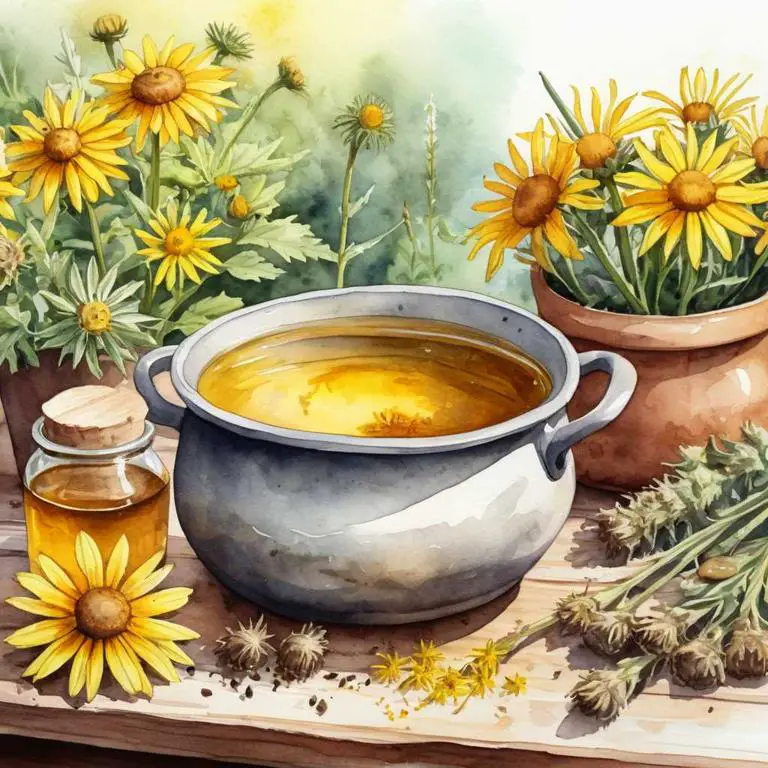
Herbal decoctions for bursitis are a natural remedy used to alleviate the symptoms of this common condition.
Bursitis occurs when the fluid-filled sacs (bursae) that cushion joints and reduce friction become inflamed, causing pain, stiffness, and swelling. Herbal decoctions, such as those made from turmeric, ginger, and devil's claw, help to reduce inflammation and relieve pain by increasing blood flow and reducing joint stiffness.
Drinking these decoctions can improve daily life for individuals with bursitis by allowing them to perform everyday activities without discomfort or pain.
The following article describes in detail the most important decoctions for bursitis, including medicinal properties, parts of herbs to use, and recipes for preparations.
- 1. Artemisia absinthium
- 2. Capsicum annuum
- 3. Gaultheria procumbens
- 4. Lavandula angustifolia
- 5. Hypericum perforatum
- 6. Boswellia serrata
- 7. Curcuma longa
- 8. Zingiber officinale
- 9. Cissus quadrangularis
- 10. Ginkgo biloba
- What is the best combination of herbal decoctions to use for bursitis?
- What ailments similar to bursitis are treated with herbal decoctions?
1. Artemisia absinthium
Wormwood decoctions helps with bursitis because of its potent anti-inflammatory properties, which effectively reduce swelling and relieve pain in affected joints.
The decoction's active compounds, such as thujone and camphor, also have analgesic and antispasmodic effects, helping to calm irritated tissues and reduce stiffness.
Additionally, wormwood's antioxidant properties may help to mitigate oxidative stress and promote healthy joint function, providing lasting relief from bursitis symptoms.
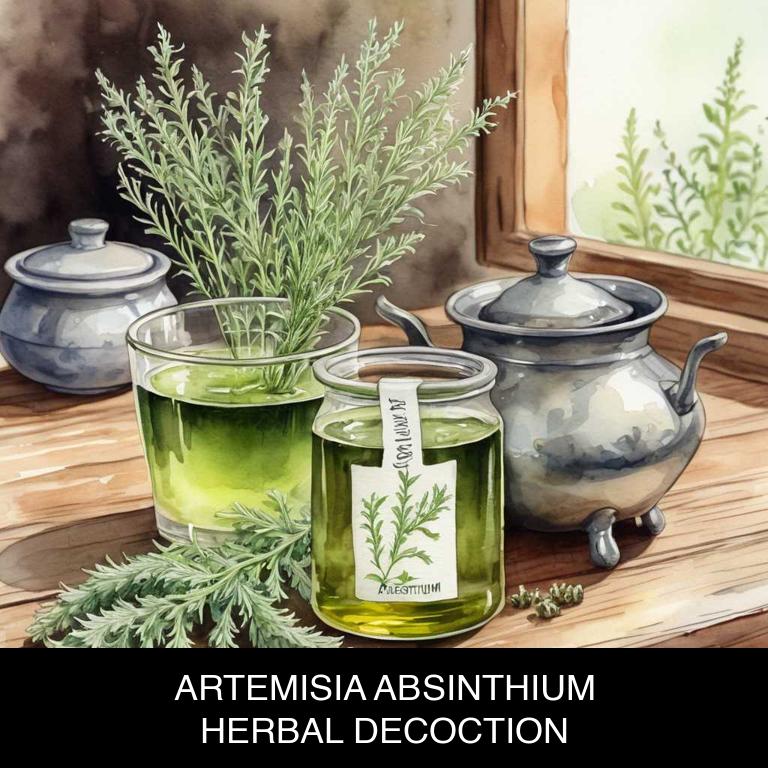
Medicinal Constituents
The list below shows the primary medicinal constituents in Artemisia absinthium decoctions that help with bursitis.
- Thujone: Acts as an anti-inflammatory agent, helping to reduce swelling and pain associated with bursitis.
- Bornyl acetate: Exhibits analgesic and anti-inflammatory properties, relieving pain and reducing inflammation in affected joints and bursae.
- Artemisinin: Demonstrates potent anti-inflammatory and antioxidant effects, helping to reduce oxidative stress and inflammation in bursitis-affected areas.
Parts Used
The list below shows the primary parts of wormwood used to make decoctions for bursitis.
- Leaves: Leaves are used due to their antimicrobial and anti-inflammatory properties, which can help reduce pain and inflammation in bursitis.
- Roots: Roots are used due to their ability to reduce inflammation and pain, making them a suitable treatment for bursitis.
- Stems: Stems are used due to their potential to reduce inflammation and relieve pain, providing relief from bursitis symptoms.
Quick Recipe
The following recipe gives a procedure to make a basic wormwood for bursitis.
- Harvest fresh or dried artemisia absinthium leaves and stems according to the desired yield and quantity.
- Chop 30 grams of the harvested material into smaller pieces to facilitate the infusion process.
- Combine the chopped artemisia absinthium with 1 liter of boiling water in a heat-resistant container.
- Steep the mixture for 10 to 15 minutes or until the liquid has cooled down to room temperature.
- Strain the decoction through a cheesecloth or a fine-mesh sieve into a clean container to remove solids.
2. Capsicum annuum
Bell pepper decoctions helps with bursitis because it contains anti-inflammatory compounds like capsicum, which reduce swelling and pain in affected joints.
The decoction also has antioxidant properties that help combat free radicals that can exacerbate inflammation. Additionally, the decoction's flavonoids and carotenoids work to relax muscles and improve circulation, further alleviating discomfort associated with bursitis.
By consuming bell pepper decoctions regularly, individuals may experience a reduction in symptoms and improved overall joint health.
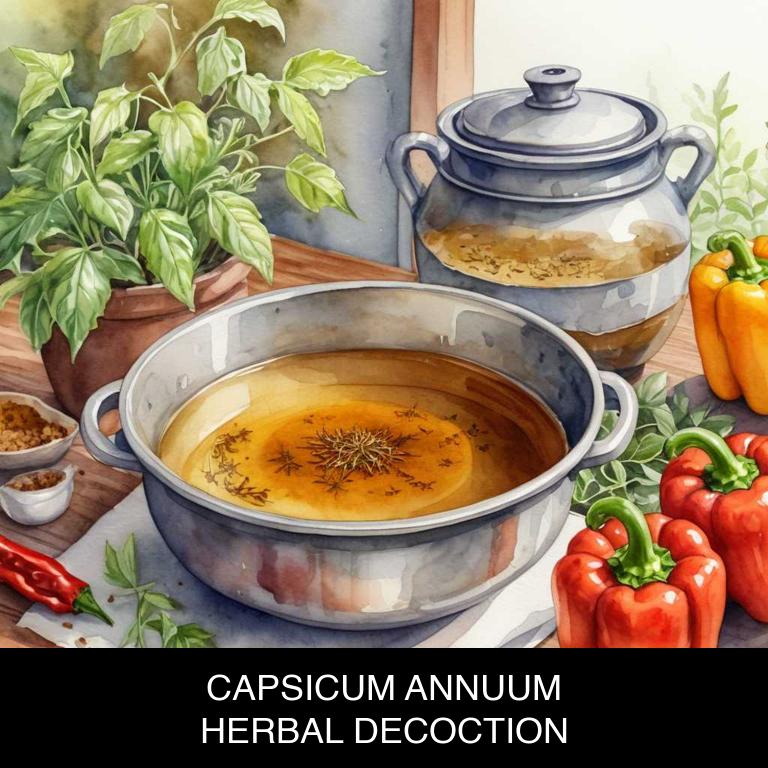
Medicinal Constituents
The list below shows the primary medicinal constituents in Capsicum annuum decoctions that help with bursitis.
- Capsaicin: Capsaicin has anti-inflammatory properties, which can help reduce pain and inflammation associated with bursitis by blocking the production of a chemical called substance P that transmits pain signals to the brain.
- Capsaicinoids: These compounds contribute to capsaicin's anti-inflammatory effects, further reducing swelling and pain in affected joints and bursae.
- Flavonoids: Flavonoids have antioxidant and anti-inflammatory properties, which can help mitigate oxidative stress and inflammation, promoting healing and reducing discomfort associated with bursitis.
Parts Used
The list below shows the primary parts of bell pepper used to make decoctions for bursitis.
- Leaves: The leaves are the most commonly used part for decoctions due to their high concentration of capsaicin, a compound with anti-inflammatory properties.
- Fruits (peppers): The fruits, specifically the ripe peppers, are used for their capsaicin content, which helps reduce pain and inflammation associated with bursitis.
- Seeds: Capsicum annuum seeds are also used for decoctions, as they contain capsaicin and other compounds that have anti-inflammatory and analgesic effects.
Quick Recipe
The following recipe gives a procedure to make a basic bell pepper for bursitis.
- Harvest 25-30 grams of dried capsicum annuum fruits from a clean environment to ensure purity.
- Crush the dried capsicum annuum fruits into a fine powder using a mortar and pestle.
- Mix 2 grams of the crushed capsicum annuum powder with 250 milliliters of boiling water.
- Allow the mixture to steep for 15-20 minutes to release the bioactive compounds.
- Strain the decoction through a cheesecloth or fine filter paper into a clean container.
3. Gaultheria procumbens
Wintergreen decoctions helps with bursitis because of its anti-inflammatory properties, which effectively reduce swelling and pain in affected joints.
The decoction's active compound, methyl salicylate, has a similar structure to aspirin, making it a natural alternative for reducing inflammation. Additionally, wintergreen decoctions have been shown to relax muscles and increase circulation, further aiding in the relief of bursitis symptoms.
By reducing inflammation and promoting relaxation, wintergreen decoctions provide a holistic approach to managing bursitis pain and discomfort.
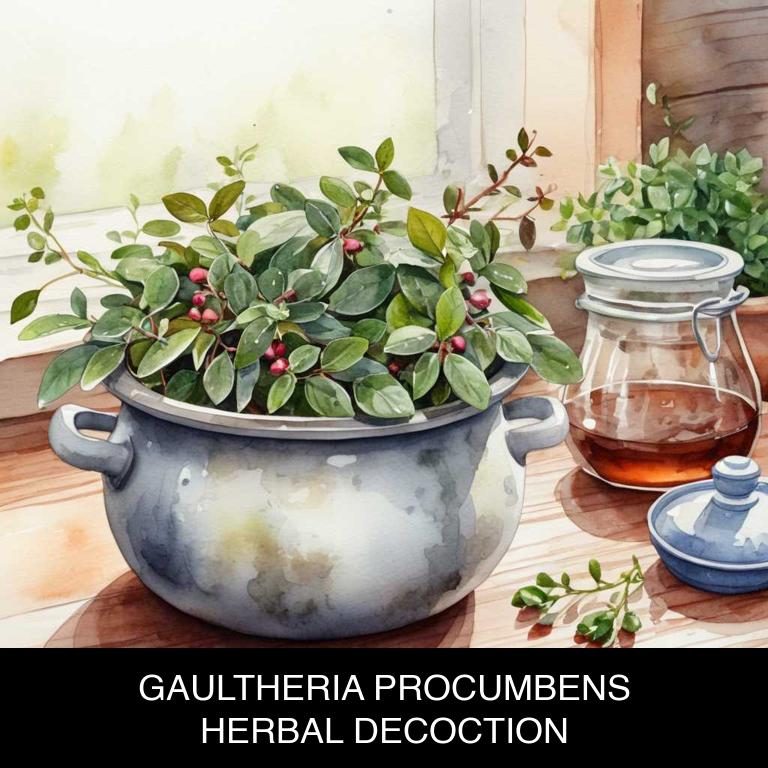
Medicinal Constituents
The list below shows the primary medicinal constituents in Gaultheria procumbens decoctions that help with bursitis.
- Gaultherin: A sesquiterpene, Gaultherin has anti-inflammatory properties that may help reduce swelling and pain associated with bursitis.
- Methyl salicylate: A phenolic compound, methyl salicylate has analgesic and anti-inflammatory properties, which may help alleviate pain and inflammation in bursitis.
- Essential oils: These compounds have anti-inflammatory and analgesic properties that may help reduce pain and inflammation in bursitis.
Parts Used
The list below shows the primary parts of wintergreen used to make decoctions for bursitis.
- Roots: These are used to make decoctions for bursitis because they contain glycosides, which have anti-inflammatory properties.
- Leaves: These are used to make decoctions for bursitis because they possess volatile oils that can help reduce pain and inflammation.
- Stems: These are used to make decoctions for bursitis because they contain a mixture of glycosides and volatile oils that contribute to their anti-inflammatory effects.
Quick Recipe
The following recipe gives a procedure to make a basic wintergreen for bursitis.
- Gather 1/2 cup of fresh or dried gaultheria procumbens leaves and stems for decoction preparation.
- Combine the gathered gaultheria procumbens in a saucepan with 2 cups of water to create a decoction base.
- Bring the decoction base to a boil over medium heat then reduce the heat to simmer for 10 minutes.
- Strain the decoction through a cheesecloth or fine-mesh sieve into a clean container to remove solids.
- Allow the decoction to cool to room temperature before refrigerating for storage or serving as needed.
4. Lavandula angustifolia
English lavender decoctions helps with bursitis because of its anti-inflammatory properties, which can help reduce swelling and pain in affected joints.
The decoction's antioxidant compounds also work to combat free radicals that can exacerbate inflammation. Additionally, lavender's natural analgesic properties provide relief from pain and discomfort. By promoting relaxation and reducing muscle tension, English lavender decoctions can help alleviate the strain and stress that may contribute to bursitis development.
This all-natural remedy offers a gentle yet effective way to manage symptoms and promote healing.
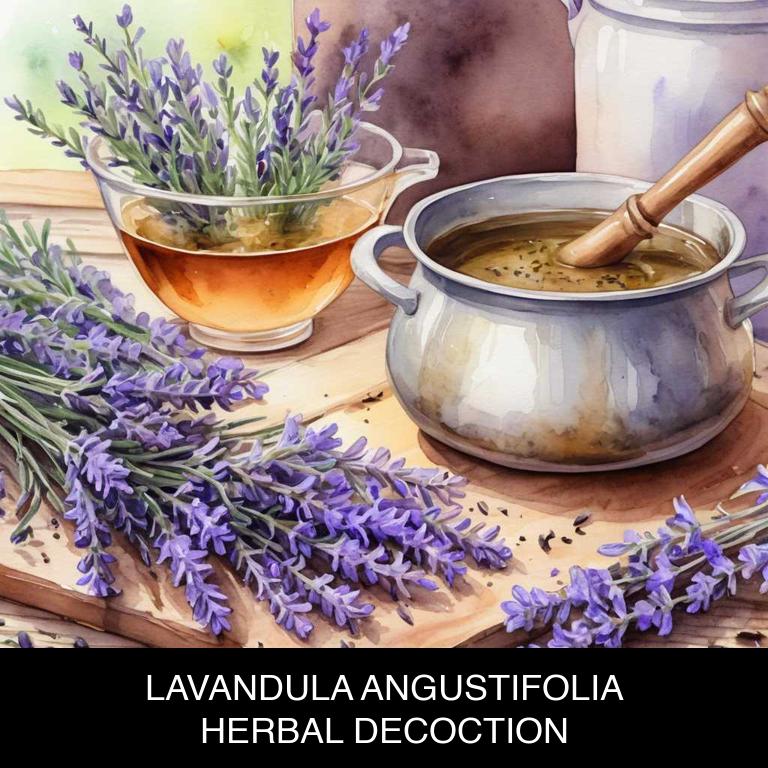
Medicinal Constituents
The list below shows the primary medicinal constituents in Lavandula angustifolia decoctions that help with bursitis.
- Linalool: This terpene has anti-inflammatory properties, which can help reduce swelling and pain associated with bursitis.
- Linalyl acetate: This terpene also exhibits anti-inflammatory and analgesic effects, contributing to the relief of bursitis symptoms.
- Rosmarinic acid: This phenolic compound has potent anti-inflammatory and antioxidant properties, which can help mitigate the inflammatory response and promote healing in bursitis.
Parts Used
The list below shows the primary parts of english lavender used to make decoctions for bursitis.
- Leaves: Rich in antioxidants and anti-inflammatory compounds, lavender leaves help to reduce pain and inflammation associated with bursitis.
- Flowers: The essential oils present in lavender flowers, such as linalool and linalyl acetate, have analgesic and anti-inflammatory properties that ease bursitis pain.
- Stems: The stems of Lavandula angustifolia contain bioactive compounds that may help reduce inflammation and promote healing in bursitis affected areas.
Quick Recipe
The following recipe gives a procedure to make a basic english lavender for bursitis.
- Gather 2-3 tablespoons of dried lavandula angustifolia flowers and place them in a clean glass container.
- Combine the lavandula angustifolia flowers with 1 quart of boiling water in a large pot.
- Reduce the heat to a simmer and let the mixture steep for 5-10 minutes.
- Strain the mixture through a cheesecloth or a fine-mesh sieve into a clean container.
- Store the cooled lavandula angustifolia decoction in an airtight container in the refrigerator for up to 3 days.
5. Hypericum perforatum
St John's wort decoctions helps with bursitis because of its anti-inflammatory and analgesic properties, which work to reduce swelling and alleviate pain in affected joints.
The decoction's flavonoids and terpenoids help to block the production of prostaglandins, hormone-like substances that contribute to inflammation. Additionally, St John's wort contains hyperforin, a compound that has been shown to have potent anti-inflammatory effects.
By targeting these underlying causes of bursitis, herbal decoctions may provide relief from discomfort and improve joint mobility.
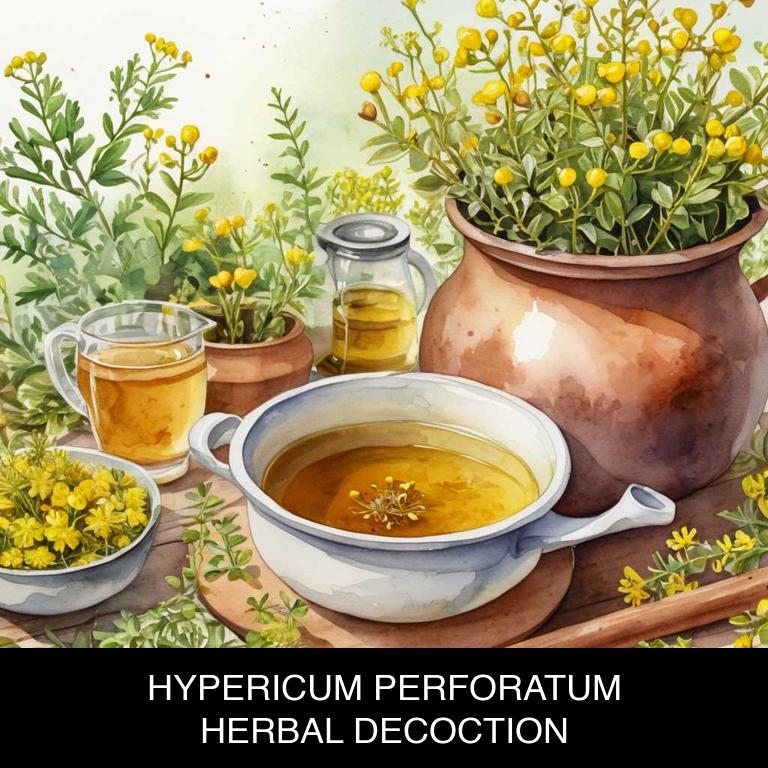
Medicinal Constituents
The list below shows the primary medicinal constituents in Hypericum perforatum decoctions that help with bursitis.
- Hyperforin: This phenolic compound is known for its anti-inflammatory and analgesic properties, helping to reduce pain and swelling associated with bursitis.
- N-[3,9-dimethyl-6-decyl-3,7-dihydro-1h-purin-2-yl]-oct-1-ene: Although less studied than Hyperforin, this compound is also thought to contribute to the anti-inflammatory and pain-relieving effects of Hypericum perforatum, making it beneficial for bursitis treatment.
- Quercetin: As a flavonoid compound with potent anti-inflammatory and antioxidant properties, quercetin helps to reduce inflammation and alleviate pain associated with bursitis.
Parts Used
The list below shows the primary parts of st john's wort used to make decoctions for bursitis.
- Leaves: They are used due to their high concentration of flavonoids and phenolic acids, which have anti-inflammatory properties effective in reducing bursitis symptoms.
- Roots: The roots of Hypericum perforatum are used for their analgesic and anti-inflammatory properties, which can help alleviate pain and swelling associated with bursitis.
- Stems: The stems are used due to their content of hypericin, a naphthodianthron compound with anti-inflammatory and analgesic effects, which can help in treating bursitis.
Quick Recipe
The following recipe gives a procedure to make a basic st john's wort for bursitis.
- Harvest 30-60 grams of fresh aerial parts of hypericum perforatum in the morning after dew has fallen.
- Dry the harvested material in a well-ventilated area at 30-40 degrees celsius for 2-3 days.
- Grind 5-10 grams of dried hypericum perforatum into a fine powder using a mortar and pestle.
- Combine the powdered hypericum perforatum with 200-300 milliliters of boiling water in a saucepan.
- Steep the mixture for 10-15 minutes then strain and discard the solids to obtain a decoction.
6. Boswellia serrata
Frankincense decoctions helps with bursitis because they have anti-inflammatory properties that can effectively reduce pain, swelling, and stiffness in affected joints.
The decoctions contain boswellic acids, which inhibit the production of pro-inflammatory compounds, thereby reducing inflammation and relieving symptoms associated with bursitis.
Additionally, frankincense has been shown to enhance circulation, which helps to flush out toxins and promote healing in the affected area, further contributing to its therapeutic benefits for bursitis sufferers.
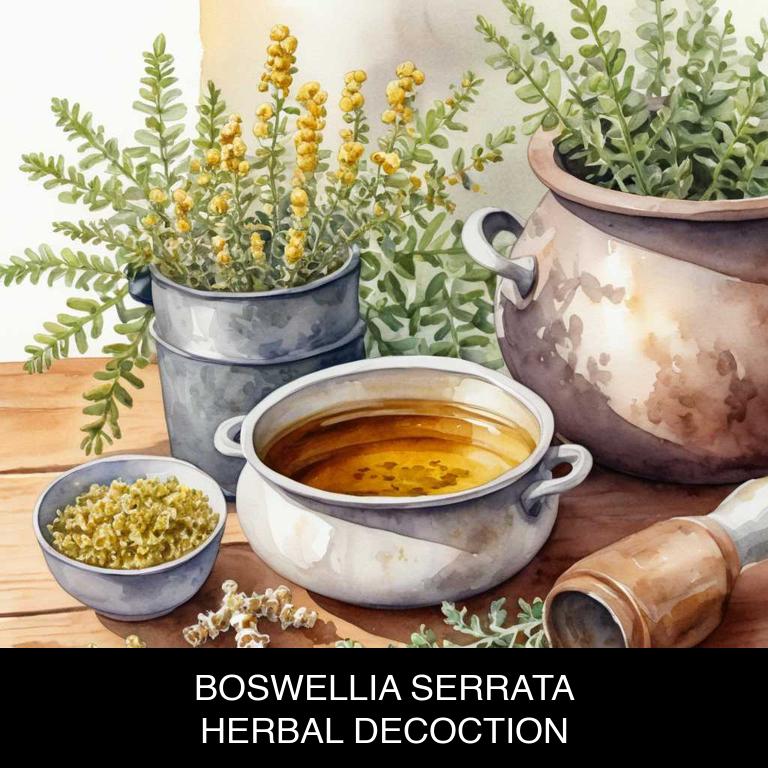
Medicinal Constituents
The list below shows the primary medicinal constituents in Boswellia serrata decoctions that help with bursitis.
- Acetyl-11-keto-β-boswellic acid: AKBA is a potent anti-inflammatory triterpenoid that inhibits the production of pro-inflammatory enzymes and cytokines, thereby reducing pain and inflammation associated with bursitis.
- Β-boswellic acid: BBA is an anti-inflammatory triterpenoid that has shown to reduce inflammation and pain by inhibiting the production of pro-inflammatory enzymes and cytokines, making it beneficial for bursitis relief.
- 3-o-acetyl-11-keto-β-boswellic acid: 3-O-AKBA is an active triterpenoid that has been shown to have anti-inflammatory and analgesic properties, helping to reduce pain and inflammation associated with bursitis by inhibiting the production of pro-inflammatory enzymes and cytokines.
Parts Used
The list below shows the primary parts of frankincense used to make decoctions for bursitis.
- Roots: They are the primary part used to make decoctions for bursitis due to their high concentration of active compounds like boswellic acids.
- Barks: They are used to make decoctions due to their rich content of boswellic acids, which help in reducing inflammation associated with bursitis.
- Stems: They are used to make decoctions for bursitis due to their secondary content of boswellic acids and other anti-inflammatory compounds.
Quick Recipe
The following recipe gives a procedure to make a basic frankincense for bursitis.
- Gather 3-4 grams of dried boswellia serrata resin and 1 liter of water for decoction.
- Boil the water in a saucepan over medium heat for 5-7 minutes to create a rolling boil.
- Add the dried boswellia serrata resin to the boiling water and reduce heat to low.
- Simmer the mixture for 10-15 minutes allowing the resin to infuse into the water.
- Strain the decoction through a cheesecloth or fine-mesh sieve into a cup or container.
7. Curcuma longa
Turmeric decoctions helps with bursitis because of its potent anti-inflammatory properties.
Curcumin, a key compound in turmeric, reduces prostaglandins, which are hormone-like substances that cause inflammation and pain. The decoction also inhibits the activity of enzymes responsible for breaking down joint tissues, thereby reducing damage to the affected area.
Additionally, turmeric's antioxidant properties help to neutralize free radicals that can exacerbate bursitis symptoms, promoting healing and reducing stiffness in the affected joints.
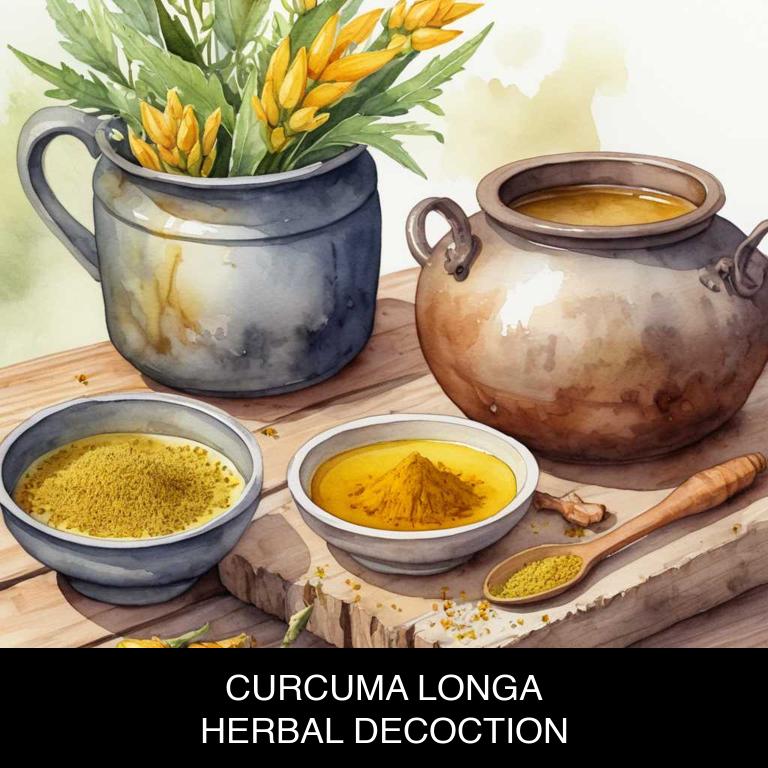
Medicinal Constituents
The list below shows the primary medicinal constituents in Curcuma longa decoctions that help with bursitis.
- Curcumin: Curcumin helps reduce inflammation and pain associated with bursitis by inhibiting the activity of pro-inflammatory enzymes such as COX-2 and 5-LOX.
- Demethoxycurcumin: DMC has anti-inflammatory properties, which help alleviate bursitis symptoms by blocking the production of pro-inflammatory cytokines and enzymes that contribute to joint inflammation.
- Tumerone: Tumerone, a sesquiterpene present in Curcuma longa, exhibits anti-inflammatory and antioxidant activities, which help in reducing oxidative stress and inflammation in bursitis, thereby providing pain relief and improving joint mobility.
Parts Used
The list below shows the primary parts of turmeric used to make decoctions for bursitis.
- Rhyzomes: Rhyzomes are used due to their high concentration of curcumin, a compound that has anti-inflammatory properties, which helps alleviate bursitis symptoms.
- Roots: Roots are used because they contain a significant amount of curcumin and other bioactive compounds that have potent anti-inflammatory and analgesic effects, making them beneficial for bursitis treatment.
- Leaves: Leaves are used due to their high content of volatile oils and flavonoids, which have anti-inflammatory and antioxidant properties that can help reduce pain and inflammation associated with bursitis.
Quick Recipe
The following recipe gives a procedure to make a basic turmeric for bursitis.
- Harvest 1-2 kilograms of fresh curcuma longa rhizomes with minimal damage to their skin.
- Wash the rhizomes thoroughly under cold running water to remove dirt and debris.
- Peel and slice the rhizomes into thin pieces approximately 1-2 millimeters in thickness.
- Boil 1 liter of water and add 30 grams of the sliced rhizomes for 10 minutes.
- Allow the decoction to cool down and strain it to obtain the liquid extract.
8. Zingiber officinale
Ginger decoctions helps with bursitis because it contains compounds that have potent anti-inflammatory properties.
The decoction's active ingredients, such as gingerols and shogaols, work by reducing inflammation in the affected area, thereby relieving pain and swelling associated with bursitis. Additionally, ginger has been shown to improve blood flow and reduce oxidative stress, which can further contribute to its therapeutic benefits in alleviating symptoms of this condition.
By promoting healthy joint function and reducing discomfort, herbal ginger decoctions can provide effective relief for individuals suffering from bursitis.
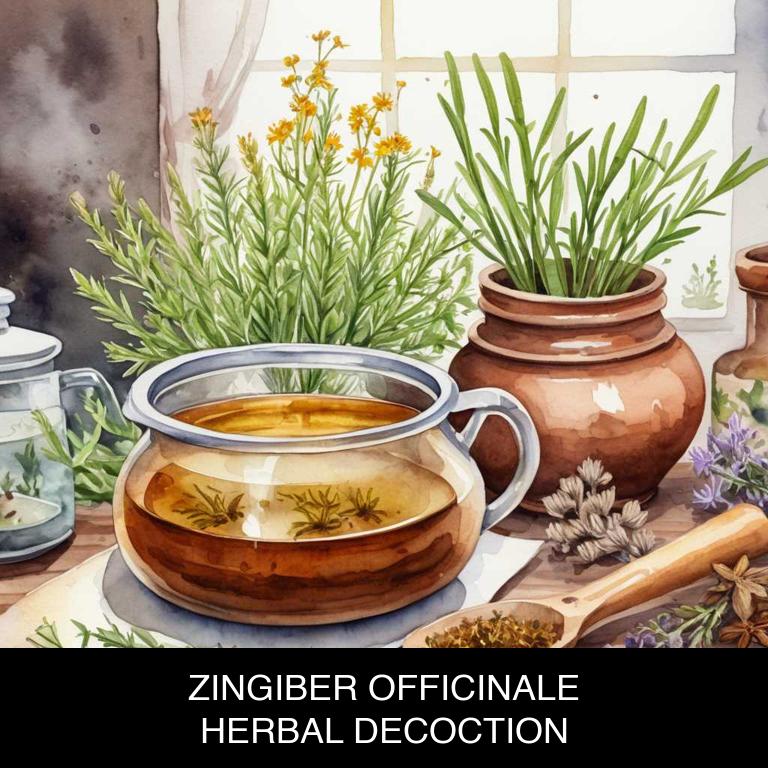
Medicinal Constituents
The list below shows the primary medicinal constituents in Zingiber officinale decoctions that help with bursitis.
- Gingerols: These compounds, particularly [6]-gingerol and [8]-gingerol, have anti-inflammatory properties that help reduce swelling and pain associated with bursitis.
- Shogaols: Similar to gingerols, shogaols also exhibit anti-inflammatory activity, which can help alleviate the inflammation and discomfort caused by bursitis.
- Curcuminoids: Curcuminoids, particularly curcumin, have potent anti-inflammatory and antioxidant properties that can help reduce inflammation, pain, and oxidative stress associated with bursitis.
Parts Used
The list below shows the primary parts of ginger used to make decoctions for bursitis.
- Rhyzomes: Rhyzomes are the most used part due to their high concentration of active compounds, such as gingerols and shogaols, which have anti-inflammatory properties that help alleviate bursitis pain.
- Roots: Roots are another commonly used part, as they contain similar active compounds to rhyzomes and are often used in traditional medicine to reduce inflammation and relieve pain associated with bursitis.
- Barks: Barks are sometimes used, particularly in combination with rhyzomes and roots, to enhance the anti-inflammatory effects of the decoction and provide additional relief for bursitis symptoms.
Quick Recipe
The following recipe gives a procedure to make a basic ginger for bursitis.
- Measure out 2-3 grams of dried zingiber officinale root and place it in a clean glass container.
- Combine the measured root with 250 milliliters of boiling water in a saucepan.
- Reduce the heat to a simmer and let the mixture steep for 5-7 minutes.
- Strain the decoction through a cheesecloth or fine-mesh sieve into a separate container.
- Allow the decoction to cool before transferring it to an airtight container for storage.
9. Cissus quadrangularis
Veldt grape decoctions helps with bursitis because of its potent anti-inflammatory properties, which effectively reduce swelling and pain in affected joints.
The decoction's active compounds, including flavonoids and phenolic acids, work synergistically to inhibit the production of pro-inflammatory enzymes and cytokines, thereby alleviating discomfort and stiffness associated with bursitis.
Additionally, veldt grape decoctions have been shown to stimulate blood flow and promote cellular renewal, further contributing to its therapeutic benefits for this common musculoskeletal condition.
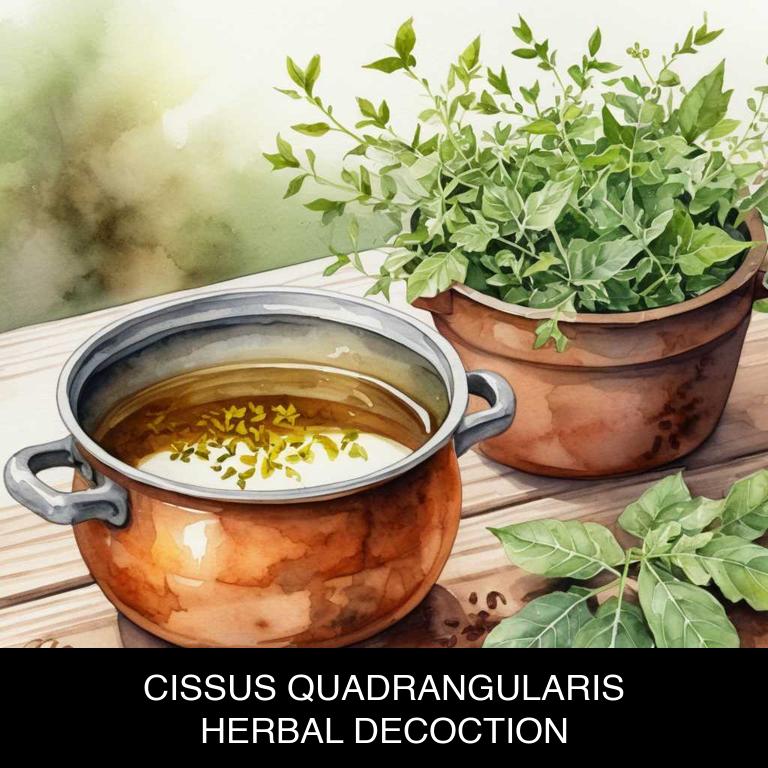
Medicinal Constituents
The list below shows the primary medicinal constituents in Cissus quadrangularis decoctions that help with bursitis.
- Quercetin: A flavonoid compound that helps reduce inflammation and alleviate pain associated with bursitis by inhibiting the production of pro-inflammatory enzymes.
- Oleanolic acid: A triterpenoid saponin that has anti-inflammatory and antioxidant properties, which help reduce swelling and alleviate pain in bursitis-affected areas.
- Kaempferol: A flavonoid compound that exhibits anti-inflammatory and antioxidant activities, which contribute to its potential in reducing inflammation and promoting healing in bursitis conditions.
Parts Used
The list below shows the primary parts of veldt grape used to make decoctions for bursitis.
- Stems: Stems are commonly used due to their high concentration of anti-inflammatory compounds.
- Roots: Roots are often used because they contain bioactive compounds that help reduce inflammation and promote healing.
- Leaves: Leaves are frequently used due to their antioxidant properties, which aid in reducing pain and inflammation associated with bursitis.
Quick Recipe
The following recipe gives a procedure to make a basic veldt grape for bursitis.
- Gather 250 grams of dried cissus quadrangularis root and stems from a reliable supplier or harvest it sustainably.
- Crush 25 grams of the collected cissus quadrangularis root and stems into fine powder using a mortar and pestle.
- Combine 1 liter of water with the crushed cissus quadrangularis powder in a saucepan and bring to a boil.
- Reduce heat to a simmer and allow the decoction to steep for 10 to 15 minutes.
- Strain the decoction through a cheesecloth or fine mesh into a clean container and discard the solids.
10. Ginkgo biloba
Maidenhair tree decoctions helps with bursitis because it contains compounds that have potent anti-inflammatory properties, which effectively reduce swelling and alleviate pain in affected joints.
The decoction's flavonoids and terpenoids also exhibit excellent antioxidant activity, which helps to neutralize free radicals that can exacerbate inflammation.
Additionally, maidenhair tree has been traditionally used to treat various musculoskeletal conditions, including bursitis, due to its ability to relax muscle spasms and improve joint mobility.
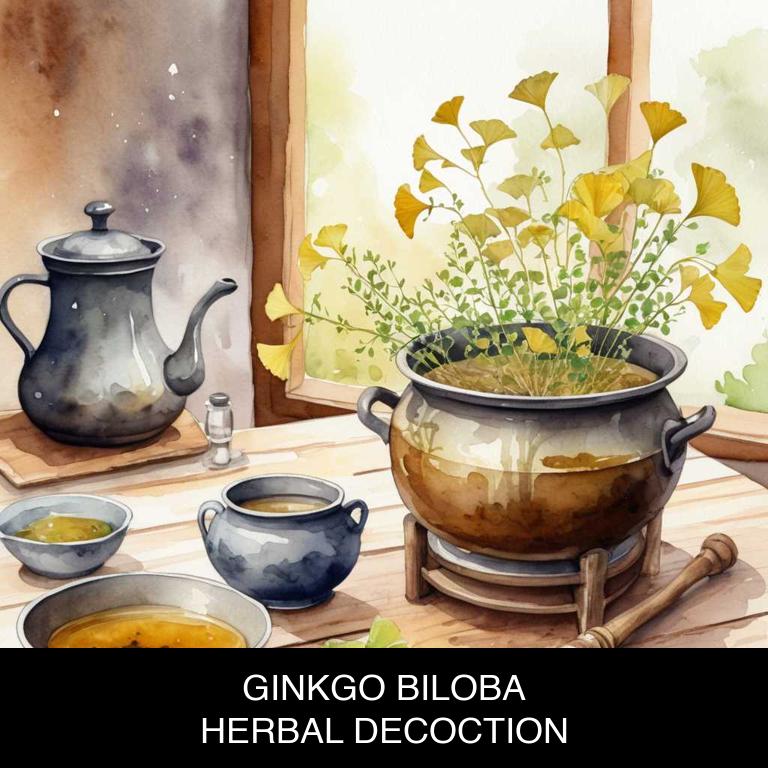
Medicinal Constituents
The list below shows the primary medicinal constituents in Ginkgo biloba decoctions that help with bursitis.
- Bilobalide: This triterpene helps reduce inflammation and modulate immune responses, which may alleviate pain and swelling associated with bursitis.
- Flavonoids: These phenolic compounds have potent anti-inflammatory properties, which may help reduce inflammation and alleviate pain in affected joints and tissues.
- Ginkgolides: These diterpene lactones have anti-inflammatory and antioxidant properties, which may help reduce inflammation, promote healing, and alleviate oxidative stress associated with bursitis.
Parts Used
The list below shows the primary parts of maidenhair tree used to make decoctions for bursitis.
- Leaves: The leaves of the Ginkgo biloba are commonly used due to their high content of flavonoids and terpenoids, which have anti-inflammatory properties that can help alleviate bursitis symptoms.
- Seeds: Ginkgo biloba seeds are used in decoctions for bursitis because they contain bilobalide, a compound that has anti-inflammatory and analgesic effects, which can help reduce pain and swelling associated with bursitis.
- Barks: The barks of the Ginkgo biloba are used in decoctions due to their flavonoid content, which can help reduce inflammation and improve blood circulation, aiding in the healing process of bursitis.
Quick Recipe
The following recipe gives a procedure to make a basic maidenhair tree for bursitis.
- Harvest 2-3 grams of dried ginkgo biloba leaves from a reputable source and store them in an airtight container.
- Rinse the ginkgo biloba leaves with filtered water to remove any impurities or debris from the surface.
- Combine the rinsed ginkgo biloba leaves with 1 liter of filtered water in a saucepan and bring to a boil.
- Reduce the heat to a simmer and let the decoction steep for 30-60 minutes to extract the active compounds.
- Strain the decoction through a cheesecloth or fine mesh into a clean container and discard the solids.
What is the best combination of herbal decoctions to use for bursitis?
The best combination of herbal decoctions that help with bursitis is a blend of Turmeric, Ginger, and Willow Bark.
Turmeric's anti-inflammatory properties, courtesy of curcumin, reduce swelling and pain. Ginger's analgesic and anti-inflammatory effects ease discomfort and stiffness.
Willow Bark's salicylic acid content provides further pain relief and anti-inflammatory benefits. These herbs work together to alleviate bursitis symptoms, promoting healing and reducing inflammation.
This combination can be consumed as a decoction or added to a warm bath for enhanced relief.
What ailments similar to bursitis are treated with herbal decoctions?
Ailments similar to bursitis/decoctions.html">bursitis/decoctions.html">bursitis that are treated with herbal decoctions are tendinitis, arthritis, and gout.
Decoctions made from herbs such as turmeric, ginger, and willow bark have anti-inflammatory properties that help reduce pain and swelling in these conditions.
Additionally, herbal decoctions containing ingredients like cayenne pepper and arnica may also be used to treat sprains, strains, and bruising, providing relief from discomfort and promoting healing.